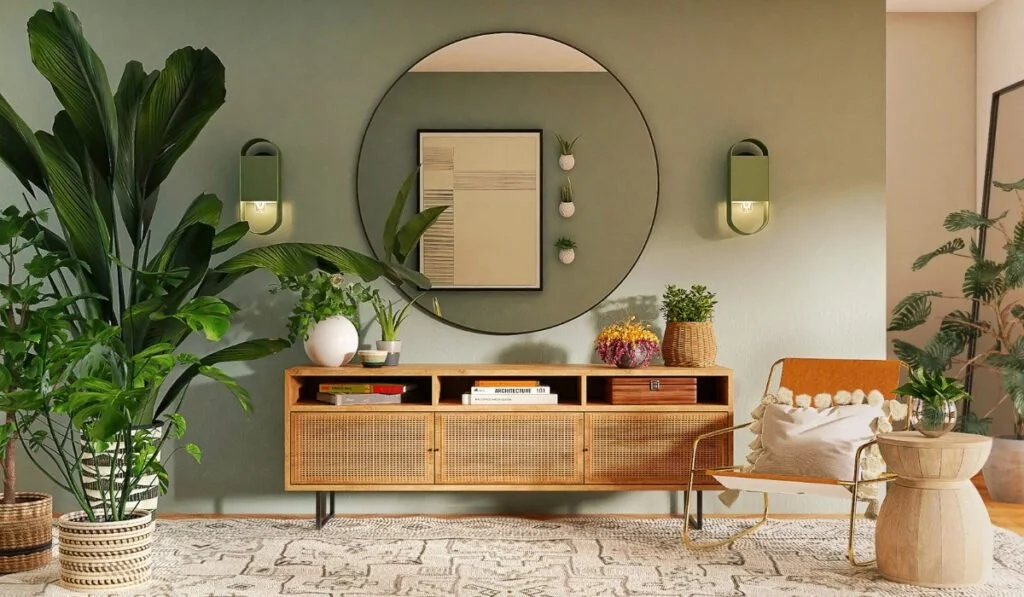Designing a sustainable home interior involves incorporating eco-friendly materials and energy-efficient systems to create a living space that minimizes environmental impact.
PHOTO: Decorilla
Do you want a living space that’s environmentally friendly, socially responsible, and economically viable? Perhaps you may want to consider shifting to a sustainable home with interior design that prioritizes sustainability. It encompasses the use of sustainable materials, energy-efficient systems, and responsible sourcing practices to minimize the environmental impact of interior design while promoting a healthy and comfortable living environment.
Sustainable home interior design is significant because it creates spaces that prioritize the well-being of both occupants and the planet. By embracing sustainable design principles, homeowners can contribute to the global effort to mitigate climate change.
Principles of Sustainable Interior Design
Sustainable interior design is a crucial aspect of creating healthy, environmentally friendly, and aesthetically pleasing living spaces. By incorporating sustainable practices and principles into interior design, we can minimize our ecological footprint, reduce waste, and promote a more sustainable way of living.
Selecting sustainable materials is one of the principles of sustainable interior design. Opting for materials that are recycled, renewable, non-toxic, and locally sourced minimizes the materials’ environmental impact.
Designing for energy efficiency is another fundamental principle of sustainable interior design. Integrating energy-saving measures such as LED lighting, programmable thermostats, and energy-efficient appliances reduces energy consumption and lowers utility costs, according to the Society of British and International Interior Design. Conserving water is another vital aspect of sustainable interior design. Installing low-flow faucets, toilets, and showerheads reduces water consumption.
Sustainable Furniture and Furnishings
PHOTO: Sustainable Jungle
Sustainable furniture and furnishings refer to products that are designed and produced with a focus on minimizing their environmental impact. One of which is reclaimed wood furniture. Furniture made from reclaimed or salvaged wood reduces the demand for new timber and helps prevent deforestation.
We also have bamboo furniture. Bamboo is a fast-growing and renewable resource that can be used to create durable and stylish furniture. There are also those that are made from recycled materials. Furniture and furnishings made from recycled materials help divert waste from landfills.
Additionally, there is low VOC (Volatile Organic Compound) upholstery that reduces the release of harmful chemicals into the air. You can also find Sustainable bedding including mattresses made from natural and organic materials, such as organic cotton, natural latex, or wool.
Sustainable Home Accessories and Décor
PHOTO: Architectural Digest India
When it comes to sustainable home interior design, paying attention to the small details is just as important as considering the larger furniture pieces. Sustainable home accessories and décor play a significant role in enhancing the aesthetics of space while aligning with eco-friendly principles.
Home accessories such as cushions, throws, and curtains made from organic fabrics like organic cotton, hemp, linen, or bamboo are free from harmful chemicals and pesticides, promoting a healthier indoor environment.
In addition, home accessories created from upcycled or recycled materials, such as glass, metal, or wood, help reduce waste and give new life to discarded items. Aside from that, lighting fixtures made from sustainable materials like bamboo, recycled glass, or reclaimed wood, paired with energy-efficient LED bulbs, help reduce energy consumption.
We could also opt for wall art made from sustainable materials like reclaimed wood, recycled paper, or natural fibers. This could include framed prints, paintings, or wall hangings.
Integration of Indoor Plants and Living Green Walls
PHOTO: Quality Bath
Indoor plants and living green walls offer a remarkable opportunity to enhance the sustainability and well-being of our homes. Beyond their aesthetic appeal, plants provide numerous environmental benefits, such as air purification, temperature regulation, and humidity control.
Indoor plants are renowned for their ability to remove harmful pollutants from the air, contributing to improved indoor air quality. By absorbing carbon dioxide and releasing oxygen through photosynthesis, plants mitigate the effects of volatile organic compounds (VOCs) emitted by household materials, cleaning products, and furniture, according to Rose Morrison.
Meanwhile, living green walls and indoor plants play a crucial role in regulating indoor temperatures. Through transpiration, plants release moisture into the air, creating a cooling effect during hot seasons.
Why We Should Opt for Sustainable Home Interior
Opting for sustainable home interiors can help us create living spaces that reflect our commitment to environmental protection and social consciousness. Sustainable home interior design minimizes our ecological footprint by utilizing eco-friendly materials, reducing energy consumption, and promoting ethical production practices. Sustainable home interior enhances the aesthetic appeal of our homes and promotes a healthier indoor environment.
BillionBricks encourages such sustainable practices. In fact, we show our support for sustainability through our net-zero homes and communities. To know more about BillionBricks and our net-zero homes and communities, please email us at hello@billionbricks.org
Sources
-
Elegant Simplicity. (2021). What is Sustainable Interior Design? Retrieved from https://elegantsi.com/blog/sustainable-interior-design
-
Econyl. (2017). 5 Principles of Sustainable Interior Design. Retrieved from https://econyl.medium.com/5-principles-of-sustainable-interior-design-b390503a5176
-
Society of British and International Interior Design. (2021). A Guide to Sustainable Interior Design. Retrieved from https://www.sbid.org/a-guide-to-sustainable-interior-design/
-
Build Green NH. (2020). 9 Types of Sustainable Furniture and Why You Should Care. Retrieved from https://buildgreennh.com/sustainable-furniture/
-
Insightful Environments. (n.d.). 7 Most of the Sustainable Materials used in Office Furniture Design. Retrieved from https://www.ie-uk.com/blog/sustainable-materials-office-furniture-design
-
Amanda Lutz. (2023). How to Sustainably Decorate Your Home. Retrieved from https://www.architecturaldigest.com/reviews/home-improvement/sustainable-eco-friendly-home-decor-design
-
Rose Morrison. (2022). 9 Best Choice Materials For Eco-Friendly Home Décor. Retrieved from https://biofriendlyplanet.com/9-best-choice-materials-for-eco-friendly-home-decor/








